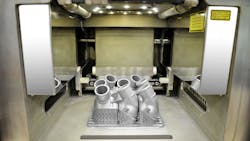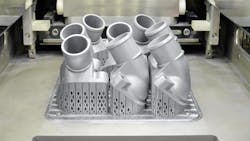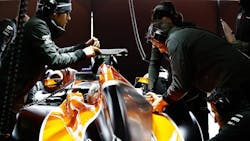Working smarter and harder: Metal 3D-printed parts for trucks
As 3D printing technology continues to find real-world applications in automotive and trucking, Mercedes-Benz Trucks has opened new possibilities with an announcement yesterday that it's now printing metal spare and replacement parts.
That follows up on the OEM's plan to begin 3D printing plastic or composite spare parts for certain European market trucks in late 2016. It may have seemed a move that would have limited applications or advantages, but the company's expansion into new materials could offer more.
For example, Mercedes-Benz noted that the first metal parts it's printing are aluminum, and "these excel with almost 100% density and greater purity than conventional die-cast aluminum parts." The 3D printing process could deliver items with a material/ structural advantage, which has also been touted in using the technology to make things from plastic and similar materials.
3D printing — especially if it can use and produce items from a wider range of materials — can offer a better way to provide spare parts and faster service for older model vehicles. That might seem counter to manufacturers' continual push to sell new ones, and more of them, but older vehicles are a diminishing fraction of their business that can tie up significant capital.
Consider large investments needed in traditional manufacturing runs; shipping, distribution and storage of parts; and maintaining and storing production tooling to make those parts. What's more, Mercedes-Benz noted that 3D printing can adeptly handle more complex items and may have very broad applications for vehicles indeed — so long as the production needs match the technology's capabilities as they currently stand.
"Especially when they have complex structures, 3D-printed metal parts in small numbers can be produced cost-effectively as infrequently requested replacement parts, special parts and for small and classic model series," Mercedes-Benz stated. "Conceivable areas of use are peripheral engine parts made of metal, in-engine parts and also parts in cooling systems, transmissions, axles or chassis."
Size matters
The scope of what can be 3D printed has grown with the introduction and broader use of larger printers. What began with desktop 3D printers — which were good for affordability and "oohing and ahing" the public, but limited in practical automotive-type uses to actually compete with traditional manufacturing — suddenly opened up with the potential to print parts more of a size that trucks and other vehicles require.
You can even print an entire vehicle body, such as companies like Local Motors and Cincinnati Inc. have demonstrated using that latter firm's Big Area Additive Manufacturing (BAAM) technology, for example. "Additive manufacturing" is the somewhat more clinical term for 3D printing.
Computer-designed parts going back for years essentially provide a built-in blueprint that could be used with such printers. Ford Motor Co., another automaker that has pioneered the use of 3D printing, said earlier this year that it was testing out the use of large-scale 3D printers from Stratasys in vehicle production.
"Imagine a 3D printer as big as a room, capable of printing auto parts of practically any size," the manufacturer said — and the technology also has the potential to make equivalent parts lighter, a major strategy OEMs use to increase vehicle efficiency.
Notably, Stratasys has been expanding other transportation applications as well with its printers. In July, the company said its machines were chosen for an Airbus project to 3D print parts such as brackets for planes to "achieve greater supply chain flexibility and improve cost competitiveness, while leveraging on reduced material consumption and waste." Back in spring, McLaren Formula 1 Racing announced it had increased its use of Stratasys 3D printers in making similar parts for faster design, installation and testing at the track.
Siemens Mobility, a branch of Siemens AG, has used Stratasys printers in making some custom "one-off" parts for trains operating in Ulm, Germany. A 3D-printed part for the nose of trains, for example, can be made to exact specifications and holds its shape when exposed to the elements better than the equivalent part made from fiberglass plastics. Thus 3D printing can even produce items with characteristics that are "simply not achievable to the same degree" with traditional manufacturing, according to Siemens Mobility.
In those and other uses, 3D printing appears to be finding its niche, though currently somewhat narrow, even as printer size and materials range are widening it. The technology makes most sense when limited quantities of items are needed, and traditional production and distribution is comparatively slow and costly.
What's been emerging are more applications, whether it's specialty situations like racing parts or various kinds of prototyping or vehicles found in limited numbers — perhaps classic cars or late model heavy trucks.
About the Author
Aaron Marsh
Aaron Marsh is a former senior editor of FleetOwner, who wrote for the publication from 2015 to 2019.


